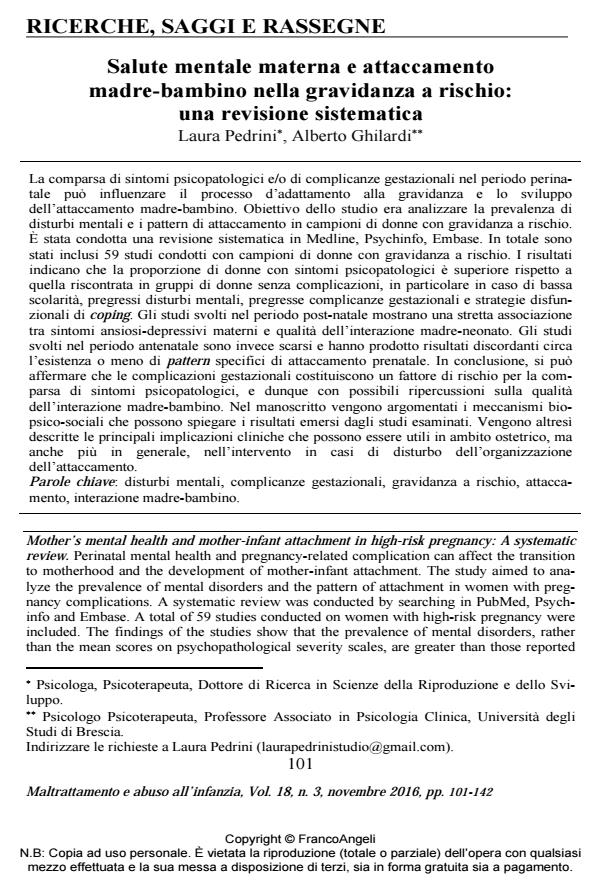Mother’s mental health and mother-infant attachment in high-risk pregnancy: A systematic review
Journal title MALTRATTAMENTO E ABUSO ALL’INFANZIA
Author/s Laura Pedrini, Alberto Ghilardi
Publishing Year 2017 Issue 2016/3
Language Italian Pages 42 P. 101-142 File size 434 KB
DOI 10.3280/MAL2016-003006
DOI is like a bar code for intellectual property: to have more infomation
click here
Below, you can see the article first page
If you want to buy this article in PDF format, you can do it, following the instructions to buy download credits

FrancoAngeli is member of Publishers International Linking Association, Inc (PILA), a not-for-profit association which run the CrossRef service enabling links to and from online scholarly content.
Perinatal mental health and pregnancy-related complication can affect the transition to motherhood and the development of mother-infant attachment. The study aimed to analyze the prevalence of mental disorders and the pattern of attachment in women with pregnancy complications. A systematic review was conducted by searching in PubMed, Psychinfo and Embase. A total of 59 studies conducted on women with high-risk pregnancy were included. The findings of the studies show that the prevalence of mental disorders, rather than the mean scores on psychopathological severity scales, are greater than those reported by healthy pregnant women. The risk for mental health impairment is higher for women with low educational level, previous mental disorders, previous pregnancy complications, and disfunctional coping strategies. During postnatal period, there are evidence of a strong association between anxious or depressive symptoms and the quality of mother-child interaction. By contrast, only few studies analyzed prenatal attachment and they provided contrasting results. In conclusion, pregnancy complications represents a risk-factor for the onset of mental disorder, thus it may affect mother-child interaction. Biological as well as psycho-social mechanisms underlying the associations described above are discussed in order to achieve better understanding and to suggest proper intervention in these cases.
Keywords: Mental health, pregnancy complications, pregnancy-high risk, attachment, mother-infant interaction.
- Mothers who kill their children: A systematic review of perinatal risk factors Marta Landoni, Sergio A. Silverio, Chiara Ionio, Giulia Ciuffo, Carolina Toscano, Ilaria Lega, Estel Gelabert, Goce Kalcev, Alba Roca-Lecumberri, Anna Plaza Estrade, Valeria Brenna, Lluïsa Garcia- Esteve, Susana Subirà Alvarez, Anna Torres Giménez, Alessandra Bramante, in MALTRATTAMENTO E ABUSO ALL'INFANZIA 2/2022 pp.33
DOI: 10.3280/MAL2022-002004 - IPV and prematurity: What does literature say? Chiara Ionio, Eleonora Mascheroni, Giulia Segre, in MALTRATTAMENTO E ABUSO ALL'INFANZIA 1/2020 pp.67
DOI: 10.3280/MAL2020-001006
Laura Pedrini, Alberto Ghilardi, Salute mentale materna e attaccamento madre-bambino nella gravidanza a rischio: una revisione sistematica in "MALTRATTAMENTO E ABUSO ALL’INFANZIA" 3/2016, pp 101-142, DOI: 10.3280/MAL2016-003006